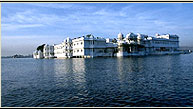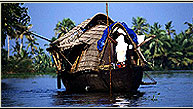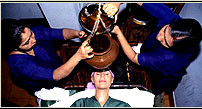-| Ladakh History | -

Ladakh's
earliest inhabitants were the Khampas nomads who grazed their yaks on this highland,
During 4-5 century the two groups of Nomads & Buddhist refugees were joined
by Dards ( tribe of Indo - Aryan origin) who migrated from southeast along the
Indus valley, It was Dards who intoduced Ladakh with irrigation & settled
agriculture.
It was during 9th century, when Ladakh became an independent kingdom under the
nobleman Nyima Gon. The eastward expansion of religion and faith towards the
Tibetan plateau started in 10th and 11th Century. With the efforts of the great
translator Rinchen Zangpo, a scholor who was associated with numerous missionaries
and monasteries in Ladakh including Alchi. In the late 14th Century, a Tibetan
pilgrim Tsong Khapa introduced Ladakh with a new order of Buddhism known as
'Gelukpa' which was headed by 1st Dalai Lama and led to the foundation of Gompas
like Tikse, Likir and Spituk.
After the various attacks by Balti Kashmir army, it was under the rule of Singe
Namgyal between 1572 and 1642. Ladakh regained its fortunes and Leh was established
as the capital of the region. It was the time during which the Leh Palace was
built. During the early 17th Century, royal family of Ladakh assisted Drukpa
monks to establish gompas at Hemis and Stakna. The entry of Islam into the region
started with the construction of a mosque at Leh which came at the price of
help and assistance given by Aurangzeb against the army of Mongolian horsemen
led by 5th Dalai Lama.
Trade-link with Tibet was resumed in 18th Century but then after Leh was able
to re-establish its influence over Zanskar, Lahaul and Spiti Valleys. The situation
in Ladakh again changed in 1830s when Dogra army led by Zoravar Singh and raided
and exiled the King to Stok. Thereafter Ladakh became the integral part of Maharaja
Gulab Singh who was appointed by General Zoravar Singh and thus remained under
the control of Jammu and Kashmir.
Today, Ladakh comprises of over 60% of the State of Jammu and Kashmir. It has
its own distinct culture and bounderies formed by great mountain ranges. After
a long dissatisfaction with centralized govt. of Srinagar, finally in September
1995, Ladakh saw the establishment of Autonomous Hill Development Council which
provided the local govt. control in the region.




 Ladakh's
earliest inhabitants were the Khampas nomads who grazed their yaks on this highland,
During 4-5 century the two groups of Nomads & Buddhist refugees were joined
by Dards ( tribe of Indo - Aryan origin) who migrated from southeast along the
Indus valley, It was Dards who intoduced Ladakh with irrigation & settled
agriculture.
Ladakh's
earliest inhabitants were the Khampas nomads who grazed their yaks on this highland,
During 4-5 century the two groups of Nomads & Buddhist refugees were joined
by Dards ( tribe of Indo - Aryan origin) who migrated from southeast along the
Indus valley, It was Dards who intoduced Ladakh with irrigation & settled
agriculture.